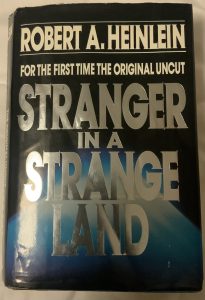Blog Overlord Post #1
So a few months ago I wandered into The Book Barn in Brunswick (2 Lincoln St) and I have just started making my way through the books I picked up there. First of all, the store is awesome! Its essentially a house that only consists of bookshelves that are packed by the man who runs the place with collectors editions of books, go check it out! The place is riddled with Sci-Fi and the owner has plenty of his own recs. Number one on his list was Dune, but having already read it, I opted for #2 — Stranger in a Strange Land (the Uncut Version) by Robert Heinlein.

The book is quite long, 525 pages to be exact, and is worth every page from the editors note through the back cover. The story of how this version came to be is fascinating and told in the editors note. In short, the version of this book that was originally published was limited to 160,000 words because the Publishers thought it would fail horribly, so Heinlein cut his 220,000 word manuscript to meet the quota. It then wins the Hugo award! But After Heinlein’s death this longer version was released and it has become an essentially unanimous decision that this version takes the cake for being the true masterpiece.
The plot focuses “The Man From Mars,” Michael Valentine Smith, a human who was born on Mars, raised by Martians, and brought back to Earth by humans to “be with his own people.” As the heir to a massive wealth on Earth, it seems the Terran government is trying to hold Michael hostage, so his Nurse and some of her friends work to free the Man From Mars. In an epic turn of events we learn that the Martian human has powers beyond the Terran human realm of understanding, and page by page we see how he utilizes and develops these power once he is free to roam the Earthly world — including through stints in carnivals, fry kitchens, temples, and what could only be described as a nudist sex cult of infinite love and empathy. The importance of Religion, Language (Martian and English), and Sex, and the entanglement of the three are huge philosophical themes in this novel, but others remain relevant including the meanings of family, truth, and love.
One interesting component of the book is that Heinlein coins several “Martian” phrases including, most notably, the word “Grok”, which you better get used to seeing and saying if you intend on reading this novel (it will briefly work its way into your thoughts while, and immediately after you read this book). One Main tenet of the plot is that “Language itself shapes a man’s basic ideas” (212), which is used as a possible explanation for why humans struggle to find happiness, and is also essential to understanding the differences between The Man From Mars and his Earthling peers.
While I really enjoyed reading this, there are some problems with this book:
TRIGGER WARNING: Sexism, Racism, Racial Slurs/Violence, Possible Sexual Coercion, (Attempted Suicide, Cannibalism, also in the book, though not mentioned below)
There definitely is some sense of gender inequality stemming from certain characters, but I have not been able to fully Grok its place amidst a seemingly anarchist / anti-capitalist / sex positive book. Women definitely derive power from their bodies throughout the story yet sex is de-stigmatized, making me think that from that point on it is purely character that drives attraction rather than physical traits. Nonetheless there is one character who regularly makes quips towards women that are belittling, despite the women playing significant intellectual, religious, and professional roles. I could not fully grok whether these were meant to be in jest and part of a two way banter between the sexes, or whether these were indeed sexist remarks (or perhaps they were both?). Maybe someone with more of a GSWS theory background can input after reading , or else I will just find out with more time to Grok. Michael often says in the book, “Waiting is until fullness.” For now, I wait.
Another similar problem has to do with religion. There are Jews, Christians, Cultists, Catholics, and Muslims in this book. They all work with each-other but one character frequently makes comments about his Muslim friend that I didn’t quite Grok to fullness but did make me feel a bit uncomfortable.
There is at least one instance where a woman coerces a man into having sex, asking multiple times and being told no, before the man gives in eventually. Technically the women knows the man’s real thoughts and that he is willing, and the man was admittedly being polite in regards to age customs, however, I Grok this could be read otherwise and in any non telepathic communication setting is most definitively rape.
Lastly, The N* Slur along with a suggestion of Lynching is used towards the main character in the final chapter. I thought this was unnecessary, although it is a reflection of the time of writing and a reminder of the hate acts that were occurring then and still occur to this day.
All this being said, the book was written in 1960 and was written as counter-culture sci-fi. While it is progressive in some elements in remains outdated in others. Overall I think that it is still very much worth a read for the thought that it provokes and the thoroughness, and entertainment value of the plot. Perhaps a second reader with a more critical theory lens will rip this to bits. But for me, this was a brilliant book that has, for better or for worse, aged.
Weird, Thought Provoking, Entertaining, Page Turner. And yes, probably controversial.
I give it a 9/10 and Very much recommend it.







